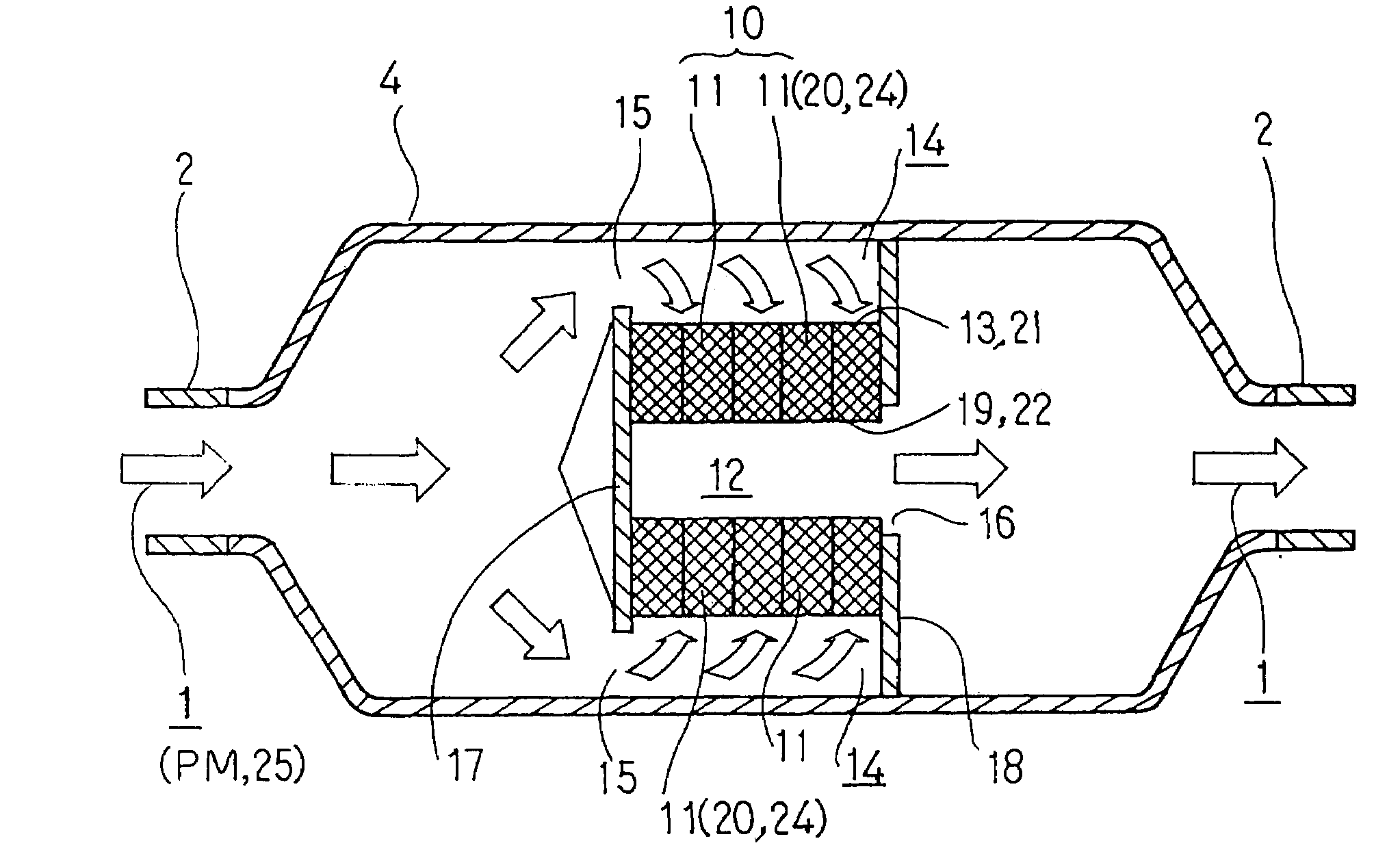Particulate matter reducing apparatus
a technology of reducing apparatus and particulate matter, which is applied in the direction of machines/engines, combustion-air/fuel-air treatment, chemical/physical processes, etc., can solve the problems of clogging intensively and biasedly, affecting the health of human body and environment, and affecting so as to minimize the trouble of cleaning and the effect of reducing the frequency of filter cleaning
- Summary
- Abstract
- Description
- Claims
- Application Information
AI Technical Summary
Benefits of technology
Problems solved by technology
Method used
Image
Examples
embodiment 1
[0164]Tests on each embodiment of the particulate matter reducing apparatus 10 according to the present invention are now described below. Tests on the first embodiment will now be described with reference to FIG. 4A.
[0165]In this first embodiment, a bench test was conducted for the collection rate using two kinds of filters 11 in which the combination of the diameter of wire 20 and the filling density thereof is different while changing the number of superpositions (laminations) of the filter 11, respectively. The test conditions are as follows.
[0166]Shape of each filter 11: outer diameter of 250 mm; inner diameter of 90 mm; and thickness of 40 mm.
[0167]Specification of each filter 11: two kinds of filters were used: (1) a filter 11 of which the diameter of the wire 20 is 0.5 mm and the filling density thereof is 25%; (2) a filter 11 of which the diameter of the wire 20 is 0.35 mm and the filling density thereof is 31%.
[0168]Type of a diesel engine 9: a normal aspiration engine of ...
embodiment 2
[0173]Tests on the second embodiment will now be described with reference to FIG. 4B. In this second embodiment, a bench test was conducted for a pressure loss using three kinds of filters 11 in which the combination specification of the diameter of the wire 20 and the filling density thereof differs while changing the number of superpositions (laminations), respectively. Test conditions are based on the first embodiment.
[0174]As a result, the measurement results as shown in FIG. 4B were obtained, whereby it was verified that the pressure loss varies with the specification of each filter 11 used even in the case of the same filter surface area. In other words, when the diameter of the wire 20 and the filling density thereof differ, the cubic volume of the filter 11 differs and thus, the pressure loss was different.
[0175]For example, in the case where two filters 11 of which the diameter of the wire 20 is 0.35 mm and the filling density thereof is 31%, were used, the surface area of ...
embodiment 3
[0177]Tests on the third embodiment will now be described with reference to FIG. 4C. In this third embodiment, a bench test was conducted for the reduction and purification rate (the collection rate) using one kind of filter 11 in the cases where only the filter 11 is used, where the filter 11 is used with the oxidation catalyst 24, and where the filter 11 is used with the oxidation catalyst 24 and the fuel borne catalyst 25 together, respectively, while changing the number of superpositions (laminations) of the filter 11. The test conditions are based on the first and second embodiments described above.
[0178]As a result, the measurement results as shown in FIG. 4C were obtained. In each case, the more the number of superpositions and the wider the surface area of the filter 11, the higher the reduction and purification rate (the collection rate). When observed in the range of a collection rate (reduction and purification rate) of 20% to 50% in the case where only the filter 11 is u...
PUM
| Property | Measurement | Unit |
|---|---|---|
| diameter | aaaaa | aaaaa |
| size | aaaaa | aaaaa |
| size | aaaaa | aaaaa |
Abstract
Description
Claims
Application Information
 Login to View More
Login to View More - R&D
- Intellectual Property
- Life Sciences
- Materials
- Tech Scout
- Unparalleled Data Quality
- Higher Quality Content
- 60% Fewer Hallucinations
Browse by: Latest US Patents, China's latest patents, Technical Efficacy Thesaurus, Application Domain, Technology Topic, Popular Technical Reports.
© 2025 PatSnap. All rights reserved.Legal|Privacy policy|Modern Slavery Act Transparency Statement|Sitemap|About US| Contact US: help@patsnap.com



